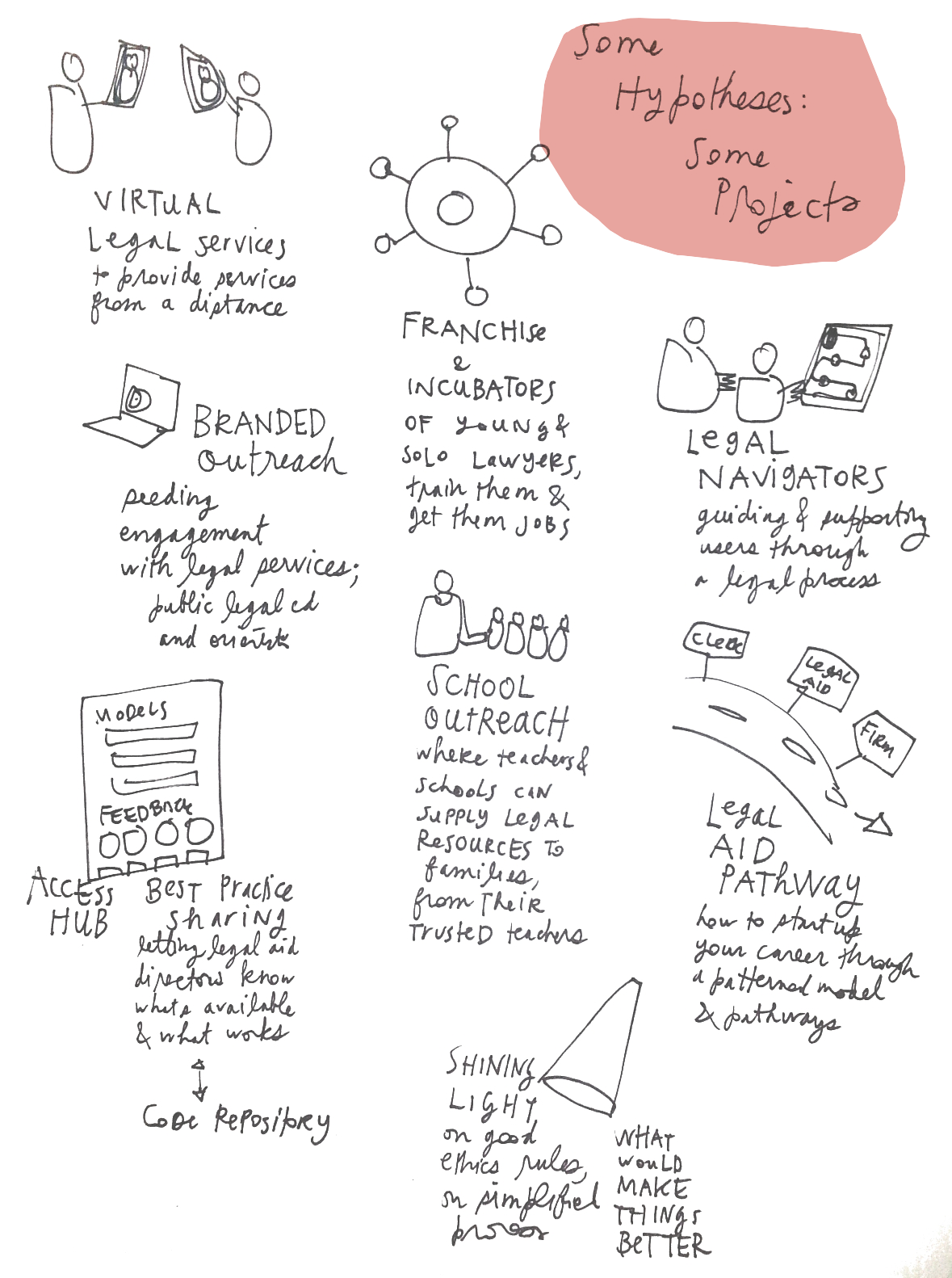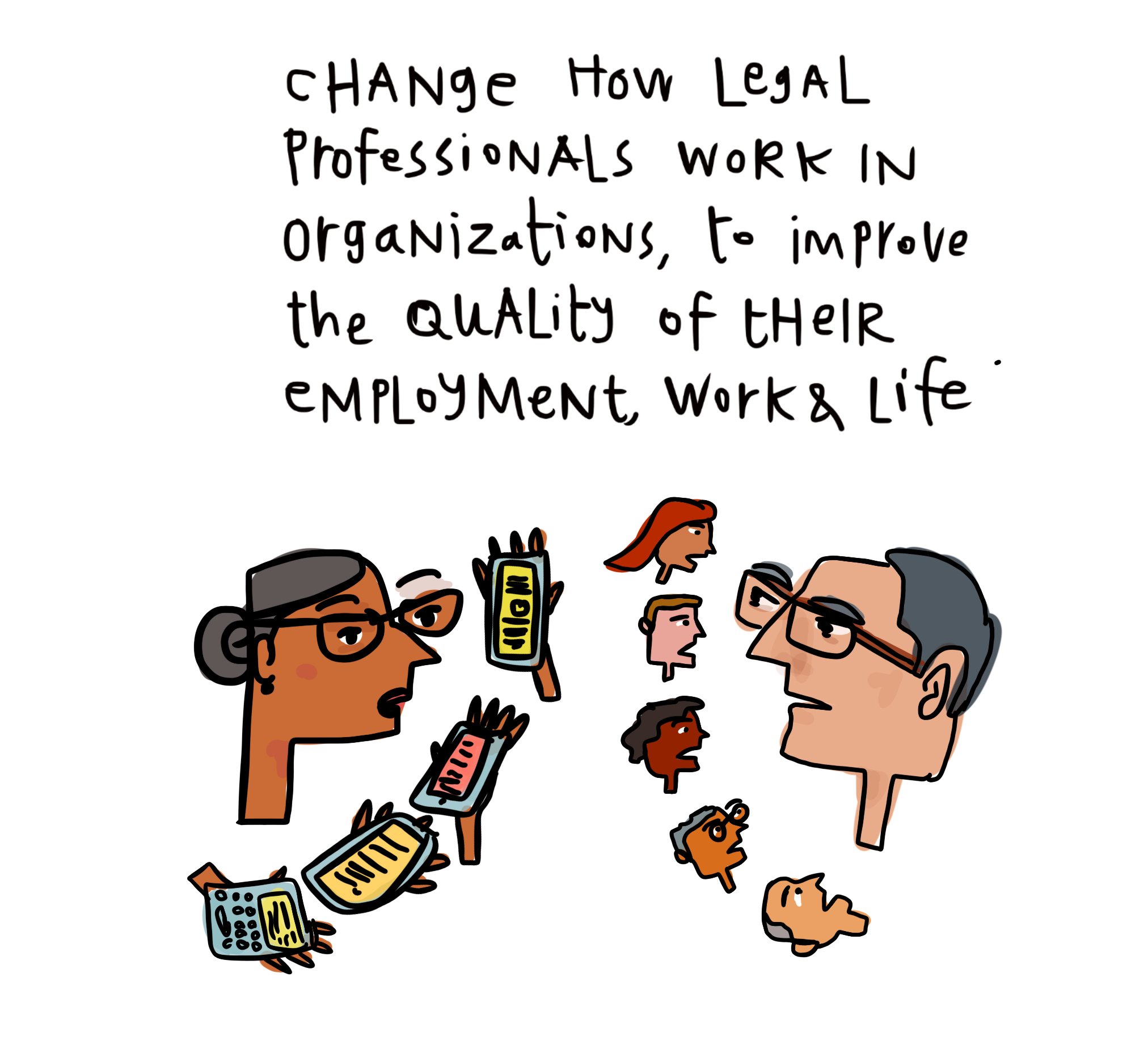In this final chapter, I present a horizon for new designs, promising directions, and needed research for the legal design community to tackle.
The Shortlist of a Legal Design Agenda
For those of us passionate about making the legal system more user-friendly, what should we be working on? I’ll share my agenda, of where I’ve seen the most interesting and meaningful challenges to tackle with legal design.
- Promote 100% Access through User-Driven Innovation
- Devise Better Modes of Legal Professionals Working Together
- Incubate & Launch A New Type of Legal Leader
- More User Research, More Feedback, and Participatory Design
1. 100% Access, through User-Driven Innovation
Everyone should have access to the justice system. The courts and legal assistance should serve all those with disputes, or otherwise in need of using the legal system to solve their life problems.
There are so many possible interventions to launch, to promote legal empowerment. I have been building a collection of current projects and new concepts for access over at my Legal Design Lab.


We need to invest in Human-Centered Legal Systems, from outside-in and inside-out. Meaning, we need to craft better interfaces on top of the system that let us use it intuitively and accessibly — but also a better system design itself, with more intuitive and accessible rules, procedures, and organizational structures.
This is my sketch of where we can intervene for a a more accessible legal system — the front-ends and the back-ends to play with and change to improve how it serves people.

We need to build interfaces on top of the legal system that make it much easier to use.
 This front-end, back-end approach leads to a big insight: the more we improve the interfaces with which people interact with the legal system, the more we can improve the actual system itself. As we are smarter about what kinds of ways to present legal info, we can then improve the underlying legal system as well.
This front-end, back-end approach leads to a big insight: the more we improve the interfaces with which people interact with the legal system, the more we can improve the actual system itself. As we are smarter about what kinds of ways to present legal info, we can then improve the underlying legal system as well.
There is a responsive loop: making better interfaces and tools on the front-end, user-facing part of the system can then make it clear where the systems themselves are defective, confusing, and in need of the most change. Making the user experience better can lead to systemic innovation too.
One last point on this track of Access to Justice innovation: we need to make the Internet work much better for people searching online for help to their problems. We need to invest in new projects, standards, and tools to give a clear, supportive online track for people searching online for help.
2. Better Ways for Legal Professionals to Work Together
Not only are laypeople not happy in the legal system, often legal professionals aren’t either. How can we use design methods to get more satisfying & effective work tracks for people who want to work in law?
We lawyers must learn to work on teams of interdisciplinary experts.
Lawyers and other legal professionals may have strong expertise in the content of law, but this does not mean that they are the right person to be designing the intervention to address the problem — or leading the project to implement this intervention.
Rather, lawyers must seek out other types of experts, who have the skill sets to properly scope the problem and stake out the path to resolution.
The lawyer should certainly be on the interdisciplinary team, taking part in the design process and providing guidance on legal content and practices. But the lawyer must cede some (or much) of the design decision-making to professional designers, computer programmers, neuropsychologists, economists, educators, psychologists, human-computer interaction experts, and other specialists who have greater familiarity with designing products and services.
Law school should be promoting this type of Interdisciplinary Training. It should teach lawyers how to be ‘product people’ and good team members. Law school needs to go beyond learning how to write, reason, and research. Thinking like a lawyer is not enough. Lawyers need to integrate their approaches to solving problems to others professionals’, so they can work together with them.
Law school classes which involve design challenges ought to ensure that there are diverse sets of graduate students enrolled in the class, or at least brought in as consultants, to ensure the process is more likely to lead to successful designs, and also to build good practices for law students to embrace.
3. A New Kind of Legal Leader
As lawyers learn to work better as an interdisciplinary team member, there is also the chance to bring out stronger leadership skills from them.

Lawyers can begin to be more strategic in the businesses they serve, and also in the legal profession. As problem-solvers, they can begin to scout new business models, new ways to apply technology to uncover opportunities and risks, and to see what new products and services need to be developed. By learning more knowledge about other domains, and by unlocking their own creative processes, lawyers can take on more leadership roles.
Lawyers who learn how to interpret and harness technology, as well as how to shape new kinds of business models and legal service organizations, can capture the huge middle class market for legal services.
 Additionally, lawyers need to take on their public service leadership roles in greater force. As the access to justice crisis continues to grow, it is the next generation of lawyers who need to devise better ways to get help, guidance, and resolution to more people.
Additionally, lawyers need to take on their public service leadership roles in greater force. As the access to justice crisis continues to grow, it is the next generation of lawyers who need to devise better ways to get help, guidance, and resolution to more people.
This means experimenting with new modes of pro bono, public service, and legal aid. The old generation has not been able to scale up to meet the needs of the public. We need more leadership from both public service and corporate lawyers to think through what more effective ways to get legal guidance to more people can be.
4. More User Research and Participatory Design
In all of this discussion about redesigning the legal system, we need to deliberately and constantly integrate the voice of the people whom we are serving.
It is not enough to announce that we are client-centered, or that we serve the public. We need to engage in high quality research into what people want from legal services, and what kinds of a system will best serve them. This means more surveys, focus groups, interviews, and qualitative research into users needs. It also means more random controlled trials and rigorous study of what interventions work best.
Additionally, we need to engage our target public in participatory design cycles, in which experts work along with lay people to create the new models for legal service.

In a participatory design cycle, all kinds of stakeholders are defining the vision of what should be created and funded. They propose projects, test them, and refine them — rather than a group of ‘experts’ defining what will work, funding it, deploying it, and then finding out if people will actually use it or not.
This means giving more voice, respect, and trust to lay people, to have them as decision-makers along with lawyers, about how the legal system should be.
A Final Message
Thank you for reading through this prototype of a book! I leave you with four final principles, to guide your work in bringing about a new
Spread Innovative Practices & Culture: From for-profit law firms to non-profit courts and legal aid groups, our mission is to develop methods for user-centered innovation in the legal sector. This means bringing design & technology skills to these organizations, and creating new types of cultures and organizations that are more creative, experimental & user-centered.
Put the Lay Person First: Even if current legal systems were not designed with the lay person as the primary user, our work is. We want to put user-friendly interfaces on top of obscure & intimidating systems. And we want to change these systems at their core, to make them serve the lay person primarily. We want not only to demystify the legal world for the non-lawyer, but we want to fundamentally empower lay people to get in charge of their lives.
Open Learning: We want to build a publicly available knowledge base about how to bring about innovation in the legal sector. This means being open about process, success, and failure — sharing best practices — and creating products that are open-source and usable by others.
Agile, Intentional Prototyping: Our design work aims for implementation & real-world impact, but the best path to get there is through rough, early prototyping of ideas that can be tested, edited and scaled. Quick, short pilots testing out specific propositions will get better feedback, more learning, and a better ultimate outcome than long, cautious development cycles.






